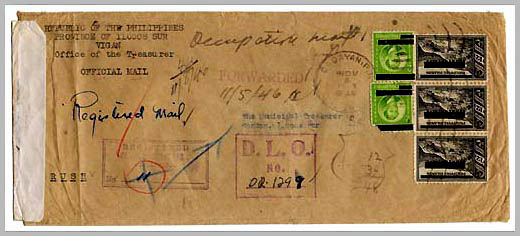|
|
|
|
|
|
|
|
|
|
|
|
|
|
 
1943 NOVEMBER 1: CAOAYAN to CANDON, ILOCOS SUR Registered official mail franked with 2c x 2 and 12c x 3 Provisionals for 40c franking, overpaid by 3c the 37c rate (25c quintuple rate plus 12c registration fee) return address of Office of the Treasurer, Vigan, Ilocos Sur, turned cover from the Bureau of Posts, unused but addressed from LIDLIDDA, ILOCOS SUR to VIGAN. CAOAYAN #11
Registry postmark, deleted in blue crayon. Handstamped in purple
Cover received with an attached article entitled "Phun With the Philippines / THE STORY OF A COVER by R. L. Griffin. Inscribed on the page is the source "W-SC - 13 July 71". The entire article is reproduced here under. If you want to get into a "phrustrating phase" of cover collecting just try regularly used covers of the Japanese Occupation of the Philippines or for that matter ANY occupation covers of the major wars of the century. The field is infinite, how about France in World War II or the current Israel occupied areas. Correspondence is curtailed through fear by the residents and inhabitants of these occupied areas or zones. Then we find the quick shortages of such things as the common commercial envelope we all must use. The tale of this cover is an interesting one showing, as it does, a fragment of "postal history." Like many others that are found, the first use of this envelope was more or less a success, and the inside shows its primary, efforts were in correspondence of an official nature between Lidlidda, Ilocos Sur, and the Provincial Treasurer, Vigan, Ilocos Sur. The envelope was a penalty type with printed corner card of Commonwealth of the Philippines: Department of Public Works and Communications, Bureau of Posts, Post Office and a blank line, under which is Official Business and (No. 6A2). The Commonwealth of the Philippines had been x'ed out and replaced with the typed-in Philippine Republic, because the apparent date of use was after October 14, 1943, when the Japanese controlled Republic was born. Now everything is set for its re-use and it was "inverted" or reversed and now carries the corner card, in typing, Republic of the Philippines, Province of Ilocos Sur, Vigan, Office of the Treasurer, Official Mail. The new addressee is The Municipal Treasurer, Candon, Ilocos Sur and the new letter was registered in Caoayan, P.I., Ilocos Sur and a cancel of November 1, 1943, 9 a.m. along with the registry stamp No. 11, also Caoayan. So far so good, but wait, what, decs that D.L.O. handstamp 1 signify? - Well it hit the Dead Letter Office in Vigan and here is a little more than an educated guess as to why. The writer had knowledge of the military activities during the time mentioned between these various postal markings and this was verified after his landing in Northern Luzon where he was actively engaged as Provost Marshal of Northern Luzon and subsequently Provincial Commander (Military Governor) of La Union Province. What happened during 1943 was that the 121st Infantry Regiment of authorized Guerillas under the field command of Colonel Barnett were encamped in the mountains adjacent to Candon and were being supplied by submarine, at the port of San Estaban. This activity put a damper on the movement of civilians throughout the entire Province of Ilocos Sur and the postmaster at Vigan sagaciously decided that the proper storage for this particular letter was their own D.L.O. Now we find the liberation forces taking over and the first indication is the penciled inscription, "Occupation mail," followed by the U.S.A. Censor shield-shaped handstamp. Then a rubber-stamp in red ink "Forwarded" with the penciled date 11/5/46 and the initials of the Censor. Some will, quickly say, "But this is after July 4, 1946, when the Philippines gained its full Independence! That is explained by the fact that particular condition was enjoyed basically by the Manila area. Remember this area is more than 407 kilometers north of Manila and full rehabilitation had not been completed as yet. Finally the letter was strip re-sealed and the climax is the beautiful Candon, Ilocos Sur - Received - Nov. 1946 backstamping. The stamps are two singles of #N1 and a vertical strip of three of N2. Could the fact that they are all affixed in an inverted condition be a connotation of distress, such as flying the flag upside down? Again those in the partial know will say that Col. Barnett was not the commander of the 121st Infantry and they would be partly correct. The real commander was Lt. Volkman, a United States Army officer, who handled the forming of the 121st infantry while he was in hiding in the Baguio area of Mountain Province and stayed there because communications were better and easier to manage than down on the coast. Both officers were well known to your writer and he attended the excellent party that was thrown when they were both promoted to full Colonels, Volkman of the U.S. Army and Barnett of the A.U.S. (Army of the United States). |
|
|